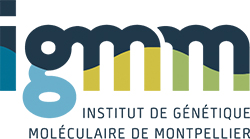ChIP-seq, RNA-seq and Hi-C: treatment, analysis and data visualization Présentiel
Dernière mise à jour : 18/11/2025
Description
Day 1: ChIP-seq and RNA-seq data pre-processing
- Initiation to Linux command lines (3 h)
- Basic notions of ChIP-seq, RNA-seq and Hi-C and their analysis pipeline, principle of spike-in normalization
- Pre-treatment of data (quality of raw data, alignments, sequencing artifacts)
- Exploration of aligned data (fragments size estimation, alignment quality)
Days 2 and 3: ChIP-seq analysis
- Generation of signal files (.wig) using the R-PASHA package
- Visualization of .wig files and isolation of enriched regions adapting detection parameters (MACS2 or using a genome browser option)
- Initiation to meta-profiling around regions of interest (genes, TSS, TES, enhancers)
- Enrichment of functional annotations (gene ontology)
- Motif search in enriched regions
- External spike-in normalization
Day 4: RNA-seq analysis
- Quantification of gene expression in RNA-seq data (RPKM)
- Spike-in normalization principle
- Differential gene expression analysis for transcripts and exons
Day 5: Hi-C analysis
- Quality controls, alignment and filtering of Hi-C data
- Generation of a chromosomal interaction map
- Visualization and interpretation of the interaction matrix
- Identification of subnuclear compartments
- Identification of Topologically Associating Domains (TADs) and loops
- Presentation of few databases and visualization tools for Hi-C
- Discussion (1 h) around participants questions and own problematics
Objectifs de la formation
- Learn how to plan a simple experiment of ChIP-seq or RNA-seq
- Acquire the skills to evaluate data quality for transcriptome and gene regulation experiments
- Understand and apply the principal methods and analysis tools for RNA-seq and ChIP-seq
- Be able to visualize data in a genome browser and extract enriched regions
- Learn how to manipulate and annotate enriched regions files using bedtools
- Become acquainted with the principal methods of analysis for long-distance genomic interactions (Hi-C) and generate chromosomal interaction maps
Public visé
Engineers and researchers in biology
Prérequis
Knowledge of basic command lines under Linux can be useful but not mandatory. A recall of basic knowledge will be proposed.
Modalités pédagogiques
Lectures (5h) and practical courses (27h) supervised by 1 teacher for 4 attendees.
Moyens et supports pédagogiques
Paper support, files in PDF format and a Linux virtual machine will be made available to the trainee.
Modalités d'évaluation et de suivi
Ongoing formative assessments throughout the course. A certificate of cmpletion is issued at the end of the training
Formateurs
Modalités tarifaires spécifiques
All our training courses are VAT exempt. Enjoy exclusive volume discounts: save 5% when registering 3-4 participants, 10% for 5-6, and 20% for groups of 7 or more. CNRS employees benefit from a special 20% discount.
Informations sur l'accessibilité
Our laboratory is fully accessible for people with reduced mobility (PRM), with dedicated facilities (access, circulation, restrooms). For any further details, please share tour request via our registration form.
